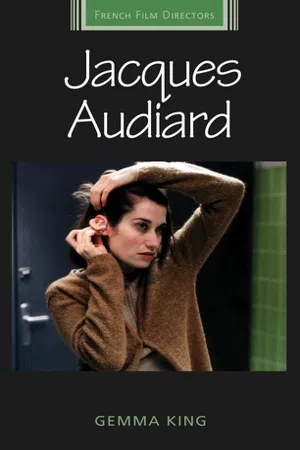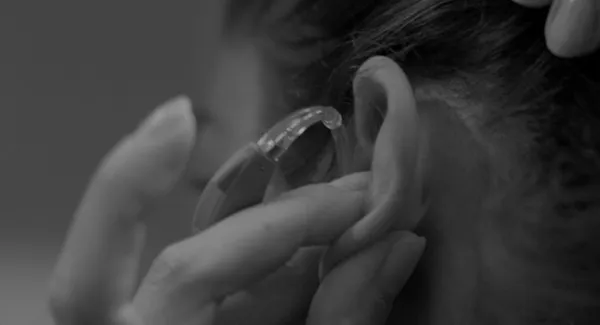![]()
Audiard est l’un des cinéastes qui filme le mieux le corps des hommes.
(Nuttens, 2012: 7)1
The body, and the boundaries that can be transgressed by and within it, are essential to the cinema of Jacques Audiard. This is despite the fact that the face is so often the quintessential body part through which to convey meaning in cinema. Many French filmmakers, among them Agnès Varda, Céline Sciamma and Jean-Luc Godard, have often employed long takes and close-up shots of characters’ faces.2 By contrast, Audiard’s films are filled with intimate, lingering close-ups on less conventionally ‘legible’ parts of the body: legs, torsos, fingers, eyeballs, backs of the neck, ears. In each of his films, the camera is drawn magnetically, obsessively, to the details of characters’ bodies. And in De battre mon cœur s’est arrêté, Sur mes lèvres and De rouille et d’os, the primacy of the body extends to the narrative, with storylines centred on disability, creation, violence and sensation that place the physical body at the forefront of plot and aesthetics.
The introduction of this book opened with some of the many powerful shots found in Audiard’s films of hands in movement, their physical functions blending into their symbolic and aesthetic ones. Yet hands are not the only body part that is emphasised, even fetishised, in these films. Audiard’s close-ups of less conventionally expressive body parts evoke Martine Beugnet’s study of the gaze-like quality of the close-up: ‘The close-up holds a key function, in its capacity to grant the content of the image a status of autonomous entity and endow the object or landscape with a face-like quality, to behold the inanimate object as that which “returns the gaze”’ (Beugnet, 2007: 108). Audiard’s characters occupy spaces between connection and disconnection, intimacy and isolation, detachment and communion. Communication is at the heart of his work, and all his films emphasise unique forms of expression, conjuring the heritage of his father’s idiosyncratic dialogue. Yet despite the narrative and thematic importance Audiard places on language, multilingualism and code-switching, his characters experience connection less through talk than through touch. Occasionally, as in De rouille et d’os, intimacy is achieved through physical contact. Yet there is a noticeable lack of healthy, sustained sexual relationships or romantic connection in Audiard’s films. Often, attraction is either unrealised (Regarde les hommes tomber, Les Frères Sisters) or untethered from emotion through the mediation of sex work (Un prophète, Un héros très discret, Les Frères Sisters, Regarde les hommes tomber), adultery (De battre mon cœur s’est arrêté) or cultural isolation (Dheepan, Sur mes lèvres).
Thus, instead of physical intimacy, touch for Audiard is often violent, and language and violence are frequently interlaced. In Un prophète, César and Malik exert their authority and underpin their verbal orders with violent acts ranging from a punch to the face to full-blown torture. In De battre mon cœur s’est arrêté, Tom communicates the consequences of betrayal with bloody beatings that escalate to the brink of murder. In Les Frères Sisters, whenever the innocent Hermann tells another person of his invention, a ‘divining chemical substance’ that illuminates gold in the river bed, he invites not industrious collaboration, partnerships and prosperity, but a new crop of would-be thieves and assassins determined to rob and kill him. In Regarde les hommes tomber, the polite words of a debt collector (‘Il faut payer maintenant, s’il vous plaît, Monsieur’3) are sinisterly undershot by the fact that he is holding the debtor’s young child while uttering them. In Un héros très discret, the protagonist’s ruse of being a former Resistance leader, nothing but words until that point, is actualised by his command to have a number of deserters killed.
As explored in Chapter 2 of this book (‘Society’), and especially the analysis of Un prophète, language is an essential element of Audiard’s cinema, and communication across language barriers is a central thematic focus and narrative device in most of his films. However, when verbal communication breaks down between characters, especially across language barriers, they also find alternative ways to communicate with their bodies. Sur mes lèvres features a deaf protagonist whose opportunities for using French Sign Language are limited as she has few deaf friends or family who sign, but who lip-reads as both a day-to-day communication system and as a means of more calculated espionage. In Un prophète, when gunshots render him temporarily deaf, Malik instructs a captive to communicate with him by signing. In De rouille et d’os, transspecies communication between human and orca gives rise to a particularly cinematic sequence through the glass wall of a pool, as the two commune through a dance of co-learned gesture. And in De battre mon cœur s’est arrêté, the French Tom and the Vietnamese Miao Lin do not share any common language, so while she teaches him piano and he teaches her French, the two improvise a communication system through a combination of body language, tone of voice, onomatopoeia, mime, and individual English instructions and Italian music terms as pared-back lingua francas. Indeed, Miao Lin’s expressive, creative enunciations and mime seem to teach us extra-lingual communication as well, given the lack of subtitles for her Mandarin-language dialogue.
Language barriers, physical distance and cultural rifts separate many of Audiard’s characters. And yet his films are not so much about separation and division as they are about using the body to forge creative bridges across such divides. Tom and Miao Lin are separated by language barriers, but they transcend verbal communication through mime, music and progressive language learning. Malik is initially excluded from the Corsican gang that controls him by their exclusionary use of the Corsican language, yet by learning to read French he is then able to teach himself Corsican and to break down these walls from the outside. Ali and Tom are both emotionally stunted by a culture of toxic masculinity that precludes healthy communication, and yet each finds release and expression in their hands, be they in legal circumstances (Ali as club bouncer, Tom as pianist) or illegal ones (Ali as bareknuckle fighter, Tom as renegade debt collector). Carla is disconnected from the auditory world that others around her live in, and is socially isolated as a result, but she bridges this social distance through her visual skills of lip-reading, while also transcending the spatial limitations of hearing.
In Audiard’s cinema, what remains unspoken, unacknowledged and undealt with bubbles up in the body. Pain is expressed through the muscles and mapped on the skin. Power is enacted in bodily movement, especially through violence and physical domination. Creativity is channelled through the sensory organs and hands, in the consumption and creation of music. Social barriers are enforced through the constraining, oppressing and policing of bodies. The characters work with their bodies: as musicians, cleaners, athletes, cooks, assassins, miners, soldiers. The camera locks on to these bodies as they work, in extreme close-ups and luxuriantly long takes that foreground the physicality of their experience, and our connection with them. In this way, Audiard’s work is cinematographically and thematically about the body in a general sense. But also, in a concrete narrative sense, his cinema is about the breaking and remaking of traumatised bodies.
The prefiguring of the body as central in these films thus forges an intimacy between characters. However, the affective power of Audiard’s bodily cinema also extends this intimacy to one between film and viewer. This is a cinema of distance: of barriers, lines, walls and rifts. But this is also a cinema of transcendence: of bridging, touch, movement and connection. Thus Audiard’s cinema recalls Martine Beugnet’s cinema of sensation, which ‘captures most acutely the alternation between the experience of being in the world as one of sensory plenitude or as radical alienation and sense of loss’ (2007: 108). But the focus on the dancing of fingers, the clenching of fists, the stretching of limbs, the caressing of skin, does not serve a purely visual function. In these films, the body is located within and across a series of lines: between differently abled and differently policed bodies, intimacy and detachment, creation and destruction, trauma and healing, pleasure and pain. In this chapter we explore how Audiard’s cinema foregrounds the body in three fundamental senses. The first emphasises creation, focusing on gender, violence and creativity in De battre mon cœur s’est arrêté. The second explores sensation and sensory perception, focusing on hearing impairment, body genres (Williams, 1991) and what I call empathic sound in Sur mes lèvres. Finally, the chapter closes on the theme of amputation, focusing on the primacy of touch and the nexus of sex, disability, loss and the female body in De rouille et d’os.
Audiard’s cinematographic focus on bodies is inherently connected with the experience of sensation, the expression of sexuality, the articulation of gender and the negotiation of disability. A growing corpus of literature in French cinema studies focused on the body can help us better understand the three films studied in this chapter. In addition to Beugnet’s cinema of sensation, Saige Walton writes of ‘cinema’s baroque flesh’ (2016), Troy Bordun of ‘extreme cinema’ (2017), James Quandt of ‘New French Extremity’ (2004) and Tim Palmer of ‘le cinéma du corps’4 (2011). These scholars each describe the foregrounding of the physical body, extreme violence, taboo intimacy and trauma in a range of contemporary French films, positing the films of directors such as Gaspard Noé, Catherine Breillat, Claire Denis, Christophe Honoré and Bruno Dumont as genre-bending examples of embodied experience on screen. While le cinéma du corps is frequently presented as a horror trope, or used to describe extremely graphic images of transgressive sex, cannibalism or other violent (self-)harm, this chapter brings these scholars’ work, alongside that of Linda Williams (1991) and disability scholar Rosemarie Garland Thomson (1997),5 to bear on De battre mon cœur s’est arrêté, Sur mes lèvres and De rouille et d’os. To be sure, Audiard’s cinema is less explicit than that of the filmmakers mentioned above, and scholars of le cinéma du corps have not used the term to refer to his films before. However, even if these films do not represent the same taboo extremes as films such as Ma mère (Honoré, 2004) or Trouble Every Day (Denis, 2001), this literature gives us the tools to explore Audiard’s films as profoundly immersive, embodied and indeed cinematic in their portrayal of the physical body.
Crea...


